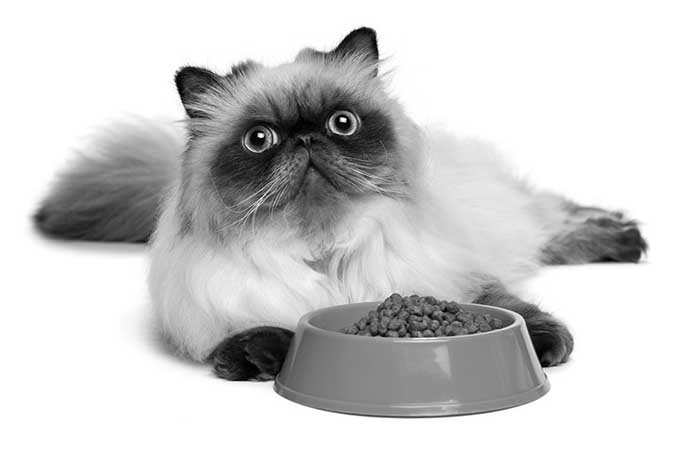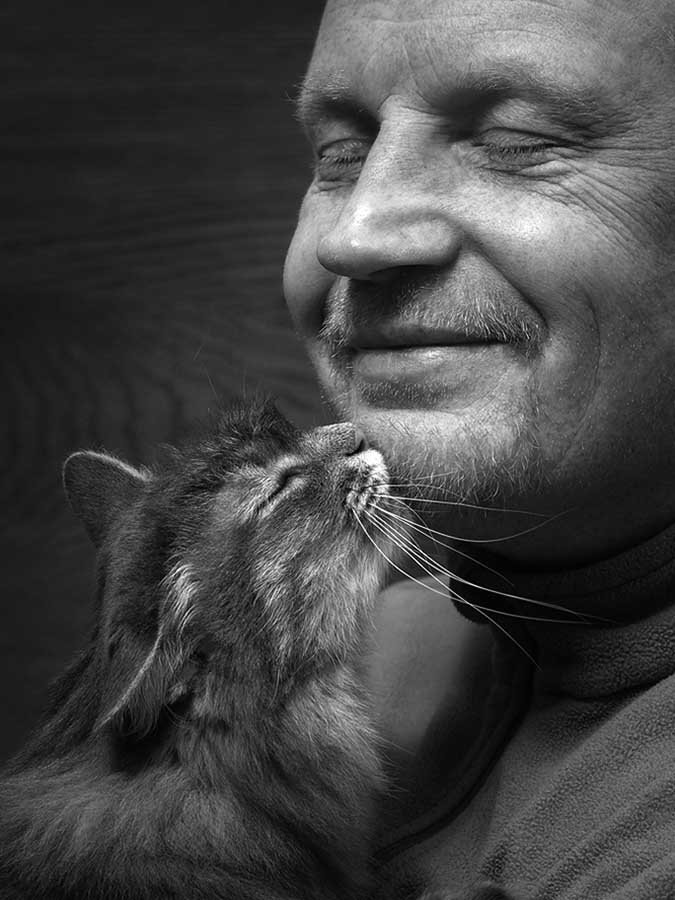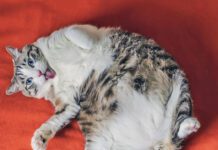Most of us think we give our cats the appropriate amount of food, but let’s be honest here: Do we take into account the treats that we slip them? Or people food? A few morsels of canned tuna — at 56 calories per ounce — can add up and we suddenly have an overweight cat.
The latest report from the Association for Pet Obesity Prevention estimates that only 38 percent of cats in the U.S. are of normal weight; 28 percent are obese and 29 percent are overweight. That translates into 55 million overweight or obese cats — some so heavy they’re unable to groom themselves and are also vulnerable to a host of illnesses.
Stepping Up. Since we’re the ones dispensing food, it’s our responsibility to take charge of their health. “There’s a disconnect in that most people don’t know how much food they’re giving,” says Joseph Wakshlag, DVM, Ph.D., ACVN, Associate Professor of Nutrition at Cornell University College of Veterinary Medicine.
His tough-love advice: “You have to figure out the best approach and find out why your cat is overweight. I suggest keeping a food diary before going to see the veterinarian.” says
Dr. Wakshlag, president of the American College of Veterinary Nutrition. “Count the treats, how much kibble or canned food, any people food, how much chicken breast. Count everything that goes in your cat’s mouth.”
One unexpected benefit: “You’ll save yourself some decent money on tests if you take a food diary to the clinic,” Dr. Wakshlag says. “It will help the veterinarian determine if your cat is really overeating. If not, then tests can be conducted to determine if your cat has a medical problem causing weight gain.”
© mdorottya | Bigstock


In this Q. and A., Dr. Wakshlag addresses other challenges — and solutions — to help your cat safely lose weight. “If the reason is not metabolic, let the veterinarian figure out ideal body weight. The bottom line is calories in and calories burned.”
Q: What are the health risks of obesity?
A: Skin problems, joint problems getting worse and more urine/bladder stone problems. Unlike dogs, cats can get the equivalent of Type 2 diabetes in which the body is resistant to the insulin produced.
Q: How does weight impact my cat’s longevity?
A: A normal weight equals longevity. The reality is that there was only one study on this topic and it was in dogs, but it applies to cats, also. The study says that with 25 percent more weight, a dog will die two years before his littermates who have a healthy body weight.
Q: How can I get my cat to lose weight?
A: When given feeding instructions, clients may be told “just feed one-quarter of a cup,” but the actual amount of food will vary tremendously depending on who is serving it. Is it precise, rounded off, eyeballed? The portions should be based on weight.
Q: How many calories does the average 8- to 10-pound cat need daily?
A: About 180 to 200 kilocalories (calories).
Q: Is kibble or canned better for weight loss?
A: It’s easier to lose weight on canned. From a volume basis, canned food is less calorically dense. It’s a great way to stimulate early weight loss in a cat.
Q: My cat has a long coat so the body condition chart isn’t useful. How can I check him for extra weight?
A: That’s the problem with body condition scores. They’re not good for pets with long coats like Himalayans. They’re just a big puff of fur. Beyond the ribcage, you have to feel the hips and abdominal area, all the specific points. You have to feel for each and every prominence through the fur.
Q: What is a safe rate of weight loss for a cat?
A: A safe rate is one to two percent of body weight per week.
Cornell


Q: What is the most common mistake owners make in trying to get their cat to lose weight?
A: One of the bigger mistakes is using over-the-counter (OTC) foods that aren’t calorie restricted. I recommend therapeutic foods or talking to a veterinarian or manufacturer about which foods are truly “lite” because there are regulations for foods that are called light: anything less than 3,100 calories per kilogram, or 2.2 pounds.
The OTC weight maintenance or weight-control diets are not designed for weight loss. They are a companion product to a regular calorie product but don’t have to be very calorie restricted, so weight loss is pretty difficult. Many of the weight maintenance or weight-control diets have more calories than light food.
Q: Do you advocate using commercial therapeutic diets?
A: I recommend therapeutic for two reasons: They’re probably higher in protein and possibly carnitine — a substance that helps turn fat into energy — that will help maintain a lean body and not fat mass. The other is that there is something to be said about the formulation of therapeutic diets, knowing that the manufacturers will put in the right amount of vitamins and minerals. They have jacked up vitamins and minerals so they meet the cat’s requirements.
Q: What should be the essential ingredient and its percentage?
A: Cats need more than 32 percent protein in dry food as labeled and more than eight percent as labeled in most canned foods. You have to pick your way through food labels, as these percentages can be hard to find.
Q: What treats can I use for a dieting cat?
A: I am a huge fan of vegetables as treats, by which I mean salad vegetables other than garlic and onions, which can cause gastrointestinal irritation and could lead to red blood cell damage. About 50 percent of cats will eat zucchini and squash if the veggies are cut up and mixed into their food, usually lightly cooked but remaining crunchy.
© kozorog | Bigstock


Q: How often should I weigh my cat?
A: It’s most important during weight loss, but even when not dieting I recommend about every four weeks. If you do it too often, you’ll get frustrated. Plus, in cats, a big bowel movement can be one percent of the body weight. Give them time, and see the trend over time.
Q: Finally, how can I resist those insistent meows and wide eyes begging for more food?
A: This is when you have to be strong. Even if your cat is bothering you, close the bedroom door and put your headphones on. Cats are persistent as we all know.
Placing the Blame: Neutering, Inactivity, Excessive Treats and Calorie-Dense Food
Brian G. Collins, DVM, Section Chief of Cornell’s Community Practice Service, is unequivocal about the extent of obesity in pets. “I’m sure at least half of the animals we see should lose a significant amount of weight. If a cat should weigh 10 pounds and he’s 12, that’s 20 percent excess body weight.”
If a cat is a little overweight at the age of 1 year, Dr. Collins advises clients to be watchful because weight gain tends to snowball. If he sees the pet is overweight, he notes it on the discharge statement: “Fluffy could stand to lose a little weight, and if you’d like, we’d be happy to calculate a diet for you.”
The best diet depends on the needs of an individual cat, Dr. Collins says. It could be low calorie, high protein or high fiber. High-fiber diets produce a higher volume of stool. Some cats lose weight using almost any type of canned food.
Owners are more likely to try expensive therapeutic diets when the one they’re using isn’t working. In the long run, Dr. Collins says, owners will save money because they won’t have to treat a medical condition related to obesity.
The amount of food to give is the biggest problem, followed by inactivity, and being neutered or spayed, which affects metabolism. Weight gain from altering is not a myth, Dr. Collins says. “Other factors are a sedentary lifestyle, excessive treats and today’s calorically dense pet food formulations.
“Most over-the-counter diets today are made with good quality ingredients, are very nutritious and are loaded with calories. Modern diets combined with an indoor lifestyle are the perfect recipe for obesity.”
Exercise is important in weight loss, but the most significant issue is the number of ingested calories, Dr. Collins says. “Some cats are so heavy it’s almost impossible to exercise in a healthy way.”
Most people have had an overweight pet, he says, and he counts himself among them. He has three cats and estimates that “1.5 of them are overweight.” They all eat a low-calorie diet.
Cats on a Diet Will Love You More
Some owners may be reluctant to put their overweight cats on diets because they worry that their cats will hate them, says behaviorist Katherine Houpt, VMD, Ph.D., professor emeritus at Cornell and a founder of the American College of Veterinary Behaviorists.
However, research that Dr. Houpt and her colleagues conducted found that cats became more affectionate when on a diet. While eating less, the cats in the study begged and meowed more, followed their people and rubbed around their legs more. Owners regarded the behavior as being more affectionate rather than appetitive — a desire to eat that Dr. Houpt compares to looking for that box of chocolate you got during the holidays. In the end, the cats lost weight and owners were happier, according to the study published in the Journal of Veterinary Behavior.
Dr. Houpt’s advice to reduce your cat’s weight is to ignore the pleas for food and play with him instead. “Harden your heart but also give your cat attention that is not fattening — that is, play with him or her.”
What seems to work best, she says: fishing pole-type toys and food-dispensing toys.



